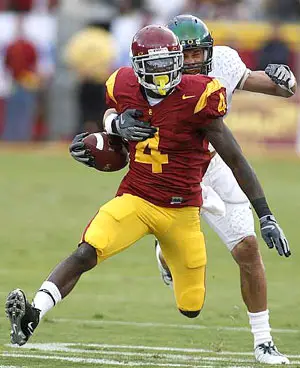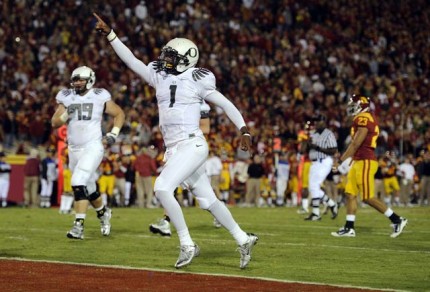Plenty of wringing of hands by Oregon football fans this week and last and the one before that, ad nauseam, about what is shaping up to be a top five recruiting class for USC in 2013, and the loss of several top targets to the Trojans.
Yes, signing day is still six months away, and high-schoolers change their minds, and anything can happen. But at this point, the Trojans are pretty much assured of a top-flight class, perhaps the best in the country. Over the past month, 4-star safety Max Redfield, 5-star DT Eddie Vanderdoes, 4-star Nico Falah, and 5-star LB Michael Hutchings all have spurned Duck offers in favor of USC.

Recruiting wars: Joe McKnight was the top running back in the nation coming out of high school in 2007. But his career at USC never met expectations.
Oregon, meanwhile? The latest Scout.com ranking has the Ducks at a mediocre No. 26 nationally overall, albeit with only eight verbals so far. A better barometer is to look at average stars per recruit, which puts Oregon at No. 6 nationally (with an average of 3.63 stars per player). USC is No. 1, with an average of 4.31 stars for its 16 commits.
For the Ducks, this is serious stuff. USC is unquestionably Oregon’s biggest challenger in the Pac-12. Since 2000, one or the other has either won or shared the conference title every season.
Winning happens when a team gets an edge over a foe anywhere they can.
Some thought the Trojans’ recruiting would take a hit as a result of sanctions handed down two years ago in the Reggie Bush case. The verdict is still out, but so far USC appears to be weathering the penalties just fine.
Coach Lane Kiffin elected to accept the two-year bowl ban immediately in 2010 but put off scholarship reductions (a loss of 10 a year for three years) until now. Going forward, the numbers will be lower — the Trojans will have 18 scholarships to hand out to the 2013 class — but the star power remains extremely high.
Duck fans, though, shouldn’t be too down. Oregon is poised to reel in another top No. 15 class. And as far as playing second fiddle to USC in recruiting, well, that’s been the case virtually every year and it hasn’t prevented the Ducks from capturing two of the last three, and three of the last five, meetings between the two schools.
Luring top talent is important, but so are coaching and player development. The same goes for the offensive and defensive systems programs utilize to gain an edge.

Settled on the field: Oregon quarterback Darron Thomas led the Ducks to a 53-32 win over USC in Los Angeles in 2010.
Indeed, below is a look at how recruiting in the recent past has gone between Oregon and USC, according to the Scout.com database (it begins with the 2001-02 season).
In parentheses, I added each season’s score between the rivals.
2011-12 — Oregon: No. 15; USC: No. 20. (38-35 USC)
2010-11 — USC: No. 4; Oregon: No. 11. (53-32 Oregon)
2009-10 — USC: No. 5; Oregon: No. 13. (47-20 Oregon)
2008-09 — USC: No. 9; Oregon: No. 26. (44-10 USC)
2007-08 — USC: No. 9; Oregon: No. 23. (24-17 Oregon)
2006-07 — USC: No. 2; Oregon: No. 9. (35-10 USC)
2005-06 — USC: No. 1; Oregon: No. 52. (45-13 USC)
2004-05 — USC: No. 6; Oregon: No. 30. (DNP)
2003-04 — USC: No. 1; Oregon: No. 15. (DNP)
2002-03 — USC: No. 1; Oregon: No. 44. (44-33 USC)
2001-02 — USC: No. 12; Oregon: No. 31. (24-22 Oregon)
Recruiting advantage?
USC, by a long shot.
On-the-field advantage?
Pretty even (in fact, if you go back further, to 1998, Oregon holds a 7-5 edge).
And that’s why they play the game between two goal posts and not in a living room or over a cell phone.
Related Articles:
These are articles where the writer left and for some reason did not want his/her name on it any longer or went sideways of our rules–so we assigned it to “staff.” We are grateful to all the writers who contributed to the site through these articles.
